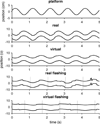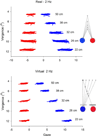Scaling of compensatory eye movements during translations: virtual versus real depth
- PMID: 23639883
- PMCID: PMC3691287
- DOI: 10.1016/j.neuroscience.2013.04.029
Scaling of compensatory eye movements during translations: virtual versus real depth
Abstract
Vestibulo-ocular reflexes are the fastest compensatory reflex systems. One of these is the translational vestibulo-ocular reflex (TVOR) which stabilizes the gaze at a given fixation point during whole body translations. For a proper response of the TVOR the eyes have to counter rotate in the head with a velocity that is inversely scaled to viewing distance of the target. It is generally assumed that scaling of the TVOR is automatically coupled to vergence angle at the brainstem level. However, different lines of evidence also argue that in humans scaling of the TVOR also depends on a mechanism that pre-sets gain on a priori knowledge of target distance. To discriminate between these two possibilities we used a real target paradigm with vergence angle coupled to distance and a virtual target paradigm with vergence angle dissociated from target distance. We compared TVOR responses in six subjects who underwent lateral sinusoidal whole-body translations at 1 and 2 Hz. Real targets varied between distance of 50 and 22.4 cm in front of the subjects, whereas the virtual targets consisting of a green and red light emitting diode (LED) were physically located at 50 cm from the subject. Red and green LED's were dichoptically viewed. By shifting the red LED relative to the green LED we created a range of virtual viewing distances where vergence angle changed but the ideal kinematic eye velocity was always the same. Eye velocity data recorded with virtual targets were compared to eye velocity data recorded with real targets. We also used flashing targets (flash frequency 1 Hz, duration 5 ms). During the real, continuous visible targets condition scaling of compensatory eye velocity with vergence angle was nearly perfect. During viewing of virtual targets, and with flashed targets compensatory eye velocity only weakly correlated to vergence angle, indicating that vergence angle is only partially coupled to compensatory eye velocity during translation. Our data suggest that in humans vergence angle as a measure of target distance estimation has only limited use for automatic TVOR scaling.
Copyright © 2013 IBRO. Published by Elsevier Ltd. All rights reserved.
Figures





References
-
- Adeyemo B, Angelaki DE. Similar kinematic properties for ocular following and smooth pursuit eye movements. J Neurophysiol. 2005;93:1710–1717. - PubMed
-
- Angelaki DE. Eyes on target: what neurons must do for the vestibuloocular reflex during linear motion. J Neurophysiol. 2004;92:20–35. - PubMed
-
- Barnes GR, Paige GD. Anticipatory VOR suppression induced by visual and nonvisual stimuli in humans. J Neurophysiol. 2004;92:1501–1511. - PubMed
-
- Clement G, Maciel F. Adjustment of the vestibulo-ocular reflex gain as a function of perceived target distance in humans. Neurosci Lett. 2004;366:115–119. - PubMed
Publication types
MeSH terms
Grants and funding
LinkOut - more resources
Full Text Sources
Other Literature Sources

